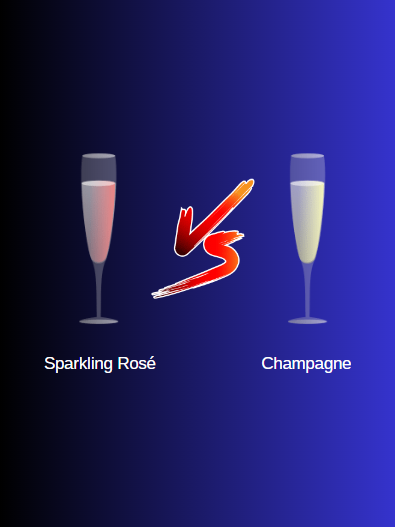
When it comes to effervescent delights, Champagne and Sparkling Wine are the two terms that come in our minds. When it comes to celebratory drinks, they are often the go-to choices. Both of them have those delightful bubbles that add a sense of joy to any occasion.
But then, what exactly sets them apart?
Something about bubbles, carbonation, protected by Law….. Pufffff…. Now I’m confused.
Been in a similar situation? I totally get you!
Here are the 10 key differences between Champagnes and Sparkling Wines that will blow your mind.
Let’s GO…
⓵ Origin and Region
The most significant distinction lies in their geographical origins.
- Champagnes are produced exclusively in the Champagne region of France, known for its cool climate and chalky soils.
- Sparkling Wines on the other hand, are crafted worldwide, such as Prosecco from Italy or Cava from Spain.
⓶ Grape Varieties
- Champagnes are typically made using three primary grape varieties: Chardonnay, Pinot Noir, and Pinot Meunier. These grapes contribute to the distinct flavors and aromas found in Champagne.
- In contrast, sparkling wines incorporate a broader range of grape varieties, including popular ones like Chenin Blanc, Prosecco, and Glera. This diversity in grape selection is the reason behind their wide range of flavors and styles.
⓷ Production Method
Another crucial difference lies in the production method.
- Champagnes follows the traditional “Méthode Champenoise”, where the secondary fermentation takes place in the bottle, resulting in complex flavors and fine bubbles.
- Sparkling wines are produced using various methods, such as the Charmat method (tank fermentation) or Carbonation, which affects the bubble size and overall taste.
⓸ Aging and Complexity
- Champagnes often undergoes a longer aging period. They typically spend several years on the lees, i.e., dead yeast cells. This extended contact period contributes to their depth, complexity, and characteristic toasty notes.
- As compared to champagnes, sparkling wines are aged for shorter time periods, and they offer a more fresh and a more fruit-forward flavor profile.
⓹ Taste Profile
Champagnes exhibits a distinctive taste profile characterized by:
- high acidity
- bright citrus flavors
- delicate floral notes
- a toasty, biscuit-like character
- the fine and persistent bubbles dancing on the palate elegantly
Sparkling wines display a wide spectrum of flavors, due to their broader range of grape varieties and production methods. These are:
- crisp
- fruity
- floral
- slightly sweet
⓺ Price and Prestige
- Champagnes are reputed for excellence and have a limited production. This is why they have a higher price point compared to sparkling wines. It has long been associated with celebrations and special occasions, adding a touch of prestige and elegance.
- Sparkling wines too are suitable for celebrating. They are often more accessible in terms of affordability.
⓻ Labeling and Regulation
- You’d be surprised to know, that the term “Champagne” is protected by law. ONLY wines produced specifically in the Champagne region of France can bear the name Champagne.
- Although, sparkling wine is a broader category that encompasses various regions and styles, which allows for more flexibility in labeling.
⓼ Carbonation and Bubbles
- Champagnes are known for their fine, persistent bubbles, which are a result of the méthode champenoise and extended aging on the lees.
- Sparkling wines have varying levels of carbonation. Some styles offer larger bubbles and a livelier effervescence.
⓽ Sweetness Levels
- Champagne offers a range of sweetness levels to cater to different tastes, from bone-dry (Brut Nature) to slightly sweet (Demi-Sec).
- Sparkling wines also present a variety of sweetness levels, thus allowing for a broader selection to suit our individual preferences.
⓾ Food Pairings
- Champagne’s high acidity and complexity make it a versatile companion for a range of foods. They pair beautifully with seafood, oysters, creamy cheeses, and delicate dishes.
- Sparkling wines, with their varying styles and flavors, can be paired with an array of dishes, from appetizers and light pastas to desserts and fruit-based desserts.
Conclusion
Champagne vs Sparkling wine — It’s more of a personal choice. In my opinion, none is superior to other. They just have different tastes based on the grapes and other ingredients used, aging period, method of production used, and several other factors. Both are worth enjoying, and are definitely worthy as celebratory drinks!
Curious about the different types of wines? Read the Blog: A Complete Guide on Types of Wines
I have fun with, result in I discovered exactly what I was taking a
look for. You have ended my four day lengthy hunt!
God Bless you man. Have a nice day. Bye
After looking at a few of the blog articles on your web site, I really like your way
of blogging. I book-marked it to my bookmark site list and will be checking back
in the near future. Please check out my web site too and let
me know how you feel.